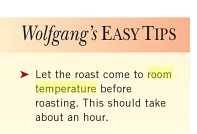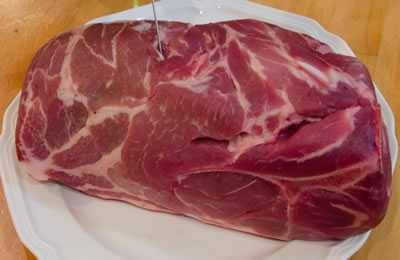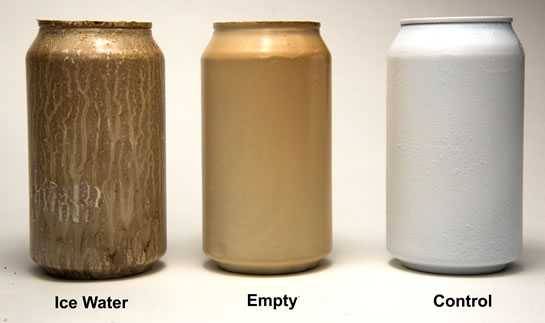Should Roast Beef Room Temperature Before Cooking
A lot of recipes, especially those for big roasts, say that you should take the meat out of the fridge an hour or two before cooking and "let it come up to room temp."
Here's the theory: Say you want a steak to be served medium rare, about 130°F. If your fridge is 38°F, then the meat must climb 92°F. But if it is room temp, 72°F, then it needs to climb only 58°F. It will cook faster and there will be less overcooked meat just below the surface.
Here's a picture of a page from a cookbook by Wolfgang Puck, a brilliant and famous TV chef with many restaurants. He says a big old roast should come to room temp in about an hour.

I tried it with a 3/4″ steak and a really accurate thermocouple. It took just more than an hour for the center to come to room temp. A 1 1/2″ steak took just over two hours for the center to come to room temp. A 4 1/2 pound pork shoulder 31/3″ thick took, are you ready for this, 10 hours! After two hours it was only 49°F in the center, and after four hours it was only 56°F. Just a bit longer than Chef Puck thinks. Worse, after five hours it began to smell funny.

Why so long? Remember, meat is about 75% water, and most of it is trapped in cell fibers. This makes it a great insulator. So even though the center of a pork butt is only 1 3/4″ from the surface, it takes 10 hours for the 72°F heat to penetrate. A mere 30 minutes in the oven at 225 to 325°F will warm the meat as much as an hour at a room temp of 72°F.
Now I know that, in theory, all contamination on whole muscle meats like steaks and roasts will be on the surface and not deep into the meat. I understand that within a minute on a hot grill all of them will be dead. But I also know that the population can double in 20 minutes at room temp. So the idea of leaving a steak at room temp for more than 30 minutes or so gives me the creeps, especially if there are cracks and pits in which microbes can hide. Especially knowing that some processors use blade tenderizers, tiny knives that cut into the muscle to soften it, but in the process push surface contamination deep into the center. This is a practice that should be banned. Especially since I will be cooking it to only 130°F, a temp that can kill microbes, but it can take hours to kill them all. But more important, over extended periods of time, putrefaction and rancidity set in, the meat starts to smell bad, and the entire flavor profile can change.
And it should go without saying, never leave poultry, burgers, or ground meat at room temp for more than a few minutes. They are susceptible to contamination within the meat and sitting around can really mess up these meats. For more on the subject, read my article on food safety.
Think of letting cold meat sit at room temp as cooking it first in a 72°F oven and then moving it to a hotter oven. It will take much longer than if you just put it in the hotter oven to begin with. But the reverse sear theory comes into play. Gentle heating helps insure that the meat's internal temperature is more even from top to bottom than if it is exposed to high heat right away. But the microbial danger zone comes into play. At 72°F microbes are very happy and reproduce with abondon. This is a major problem for poultry because contaminants can be down into the muscles, less of a problem for other meats because contamination is usually confined to the surface.
Low and slow smoking or roasting a big piece of meat to 190 to 200°F like brisket or pork shoulder. Usually cooked at 225°F these meats can take 8 to 12 hours and starting at room temp saves only about 20 to 30 minutes. The reverse sear theory is not a factor because it is cooked so long that the temp is uniform from top to bottom.
Thick cuts cooked to 130 to 165°F. A thick piece of meat like a prime rib (say 6″ thick), pork loin (4″) to be served in the relatively low temp 130-165°F range does slightly benefit if you could safely warm it to room temp before cooking. It is a shorter step from 72°F than from 38°F. It might cut cooking time by 25%. But again, total elapsed time is shorter if you move straight to the cooker.
A steak cooked reverse sear. In the reverse sear process you are heating gently in a 225°F oven during the initial stage and then searing at Warp 10 at the end. As we have shown, it can take two hours to get to room temp and in the oven/grill/pit it gets there in about 15 minutes. It is actually faster to go directly to the grill from the fridge or freezer.
A steak seared at Warp 10 first. You are clobbering the meat with a lot of heat and if you want to serve the meat at optimal medium rare, 130°F, you want the interior to remain relatively cool so it doesn't overcook. Letting the meat come to room temp is actually self-defeating. In fact, you are better off cooling it down in the freezer a few minutes.
Also, we now know thanks to the AmazingRibs.com science advisor, Prof. Greg Blonder, smoke sticks better to cold surfaces. Here are three beer cans. The one on the right sat on my desk during the experiment. The one on the left was filled with ice water and placed in a smoker. The one in the middle was empty and placed in the smoker. You can see that the cold wet surface of the one on the left attracted more smoke and thus more flavor.

So in my house, it's out of the fridge and onto the grill or oven.
Source: https://amazingribs.com/technique-and-science/myths/let-meat-come-to-room-temp/
0 Response to "Should Roast Beef Room Temperature Before Cooking"
Post a Comment